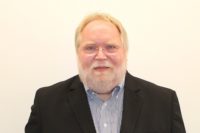To appreciate Glenn Ballard’s commitment to Lean project delivery, ask him about the fruit trees behind his Oakland, Calif., home.
The University of California, Berkeley, retired professor and project management expert has been planting his small orchard using pull planning methods. Each step is laid out, from gathering materials and researching placement (“fruit trees like a lot of sun”) to selecting the best peach, fig, apricot and apple trees.
“It’s built into my DNA at this point,” says Ballard, who’s spent 40 years as an author, educator and consultant working to improve project performance. “The magic of Lean planning is that it’s just common sense.”
This down-to-earth attitude has taken Ballard from a small Texas town to travel the world, helping save troubled projects with Lean’s simple precepts. He is a founding member of both the nonprofit Lean Construction Institute (LCI) and the International Group of Lean Construction. Ballard also serves on the Project Production Institute’s Technical Committee, the world’s foremost expert group applying operations science to complex projects.
A lifetime could never be enough to achieve the Lean ideal—to give customers exactly what they want with zero waste—but Ballard never stops trying. He came to project management almost accidently, his natural curiosity pulling him first toward ranching, teaching and business until he took a summer construction job. Now he’s working to apply Lean precepts to a variety of fields from oil drilling to filmmaking as well as to tiny backyard orchards.
“I don’t think I’ve actually had a career, I’ve had a careen,” Ballard says.
Early On
Ballard, 75, grew up in Sabine Pass, Texas, near the Louisiana border, beginning his education in a one-room schoolhouse. As a young man, he planned to emigrate to Australia to run a horse ranch, but a magazine article led him to St. John’s College in Santa Fe, N.M., instead. Later, he was pursuing an MBA at the University of California, Davis, when a summer as a pipefitter’s helper along the Houston Ship Channel changed his trajectory yet again.
“I really enjoyed working with my hands, solving practical problems. I enjoyed the people that I worked with and seeing the fruits of my labor,” Ballard says.
He began his construction career at Brown and Root Industrial Services LLC, and then at Bechtel Corp. At Bechtel he invented the Last Planner, a production control system used by construction firms worldwide.
While still at Brown and Root in 1979, Ballard was tapped to help rescue the Chocolate Bayou Project, a troubled $300-million ethylene plant in South Texas. The Conoco/Monsanto project was overbudget and behind schedule, a situation Ballard partly attributes to the owners.
“They were just like cats and dogs in a bag. They never could agree on anything. They kept changing their minds. It was a mess,” he says.
The experience truly introduced Ballard to Lean principles. “Before then, it didn’t seem like the projects were really planned and managed, they were just happening.”
Ballard’s program put the project back on schedule and saved a projected $4 million, said Construction Concepts owner Michael Casten, who worked on the project (ENR, 11/27/80).
Another colleague on the Chocolate Bayou project was Greg Howell, who taught Ballard how to conduct method studies using time-lapse photography. It was the beginning of a long collaboration—Casten helped Howell and Ballard form LCI in 1997—that only ended when Howell passed away last year.
In 1994, Casten and Howell solicited Ballard’s help to turn around the $2-billion-plus PARC upgrade project in Cardon, Venezuela. At the time, it was the Western Hemisphere’s largest gasoline refinery, with 12,000 craftsmen employed by 60 subcontractors. The Last Planner system saved billions in lost revenue, Casten says. As the three men flew from Caracas back to the U.S., they worked out the concept of LCI over lunch in Miami.
LCI’s mission is both simple and audacious: To transform a broken design and construction industry through Lean thinking, tools and techniques, and re-integrate the very siloed industry.
Approach and Adoption
“I’m absolutely convinced from my own experience that the Lean approach is the best way we humans have developed for pursuing sustainability: economic, social and environmental. It hasn’t applied to the last two like the first, but it’s coming,” Ballard says.
Ballard initially thought simply acquainting people with Lean’s concepts would be enough to effect change. And some people seemed excited—at first. Ballard tells about two general foremen with an electrical contractor who turned up at one of his seminars. Impressed, the foremen vowed to push for these new processes and promised to stay in touch.
“We waited and waited,” Ballard says. “Finally, we called one of them up. He said, ‘I’m really embarrassed, but we make too much money off the current waste in the system. We just can’t buy into it.’”
The experience made Ballard think more systematically about the obstacles to adopting Lean principles. He divided his target population into three groups: the early adopters, the “skeptical but reasonable” and the naturally resistant.
“Our strength is in the second group,” Ballard says. “They can be persuaded by argument and logic. They don’t have to have evidence that something succeeded with others before they adopt it. If those people didn’t exist, we wouldn’t have any change in anything.”
These crucial adopters also put competitive pressure on the last group from both competitors and customers. As a result, LCI membership and conference attendance exploded. “That’s a sign that we are putting pressure on them. There’s still a long way to go because the pressure is primarily in the commercial building sector and less so in industrial and infrastructure.”
Ballard keeps conducting research and publishing papers. He’s developing a book on target-valued delivery, looking specifically at the challenges of conceptual estimating. This delivery system sets targets for cost, time and product before design to avoid wasted effort and designs that violate project constraints. Designers can’t be blamed if they don’t have clear requirements to bind them, Ballard says.
Love of Restraint
“Design requires restraint because otherwise the canvas is too big. It’s not a way to restrict innovation and ingenuity, creativity, but rather focusing it so it generates value,” Ballard says.
This love of restraint is clear in Ballard’s work and speaking style, says Todd Zabelle, founder and CEO of Strategic Project Solutions Inc. and an LCI founder.
“We used to say Ballard talks in zip files,” Zabelle says. “What at first glance seems to be a strange or off-the-wall comment or question is almost always far more profound.”
David McKay was introduced to Ballard’s methods in the late 1990s while working for Aera Energy LLC, a joint venture of Shell and Mobil, in the San Joaquin Valley’s Belridge Oil Field. The company wanted to tap into an oil-and-gas field requiring drilling and hydraulic fracturing wells in a very tightly spaced configuration, overlayed by a still-operating oil field. The plan was to drill a thousand 1,000-ft-deep wells in a year. As many as 10-15 wells were clustered in a single one-acre plot, some previously existing and producing, some being drilled, some hydraulic fractured and more.
“I was not a typical project guy,” says McKay, who depended on the Critical Path Method (CPM), which uses modeling and algorithms to create work schedules. “I was initially so pleased and felt kind of like General Patton with my huge room with maps laid out on tables and Gantt charts on the wall, all ready to kick into motion. It was great until the motion actually began!”
The project crashed into itself within days, as scheduling problems and misunderstandings proliferated. Drilling rigs sat idle and mechanical construction crews literally got into fistfights with electrical crews. “It wasn’t until I went out into the field a week or so later that I really understood what a dumpster fire I had created,” McKay says.
Luckily, McKay had heard about Ballard and reached out in desperation.
“I was skeptical as to who this guy was going to be, given he was a ‘Lean’ guy and he was from Berkeley,” McKay says. “He was friendly, but utterly uninterested in small talk. Also, I was surprised to hear that he was from Texas originally and that his father had worked in the oil fields.”
Ballard immediately announced that the project was a victim of “go-and-see” scheduling. Regardless of what is scheduled in the office, the workers in the field were just trying to find a place to work. “It was wasteful and actually, at times, dangerous as work done out of proper sequence can often be,” McKay says.
Instead, Ballard introduced the idea of sequence and flow of work, where the oil field developers stopped looking at batches of work and focused on what needed to be done in the flow. With Ballard’s help, the site became one of Aera’s most important business successes.
“He changed everything about my views,” McKay says. “He introduced me to principles that were truly revolutionary in the business of development and construction. The biggest challenge has been changing the minds of the CPM community. That is deeply entrenched in construction and in the oil-and-gas business. They are often highly resistant, and understandably so, as it threatens much of what they do.”
Ballard continues to find new industries for applying Lean principles, including filmmaking. He retired from Berkeley in 2019 but remains a research associate at the Project Productions Systems Laboratory. He is also working as a Lean production adviser on a Netflix film.
“There’s so much to do and learn and many things that need to be changed. I’ll stick with it as long as I have energy,” Ballard says.





Post a comment to this article
Report Abusive Comment